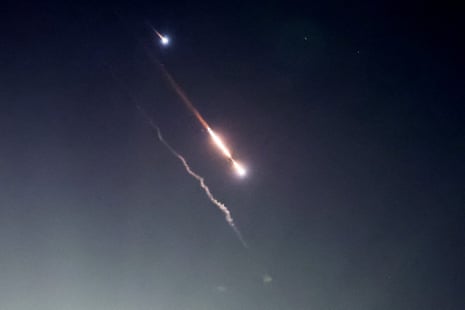A hastily assembled coalition including the US and UK has helped Israel shoot down Iranian drones over Jordan, Iraq and Syria in an effort to blunt the attack and prevent an uncontrollable escalation.
As a mass salvo of Iranian drones and cruise missiles neared its borders, Israel scrambled its fighter jets to intercept the incoming projectiles, according to Israeli news reports, and it was supported in the effort by its partners and neighbours.
Joe Biden said the US had built up its forces in the run-up to the widely telegraphed attack, and that the reinforcements had paid off.
“At my direction, to support the defense of Israel, the US military moved aircraft and ballistic missile defense destroyers to the region over the course of the past week,” Biden said in a written statement. “Thanks to these deployments and the extraordinary skill of our servicemembers, we helped Israel take down nearly all of the incoming drones and missiles. “
Royal Air Force fighter jets and refuelling aircraft were also involved, taking off from bases in Cyprus. Their role, according to the Ministry of Defence, was to fill in for the US Air Force in the sorties against the Islamic State normally carried out over Iraq and north-eastern Syria, but also to intercept Iranian drones if they came into the UK area of operations.
“In response to increased Iranian threats and the growing risk of escalation in the Middle East, the UK government has been working with partners across the region to encourage de-escalation and prevent further attacks,” a defence ministry statement said.
“We have moved several additional Royal Air Force jets and air refuelling tankers to the region. These will bolster Operation Shader, which is the UK’s existing counter-Daesh operation in Iraq and Syria. In addition, these UK jets will intercept any airborne attacks within range of our existing missions, as required.”
Reuters quoted two regional security sources as saying Jordanian jets had downed dozens of Iranian drones flying across northern and central Jordan heading towards Israel.
The report said the drones had been brought down over the east bank of the Jordan river, and had been heading in the direction of Jerusalem, while others were intercepted close to the Iraqi-Syrian border.
There was no confirmation from the Jordanian government on its military role. The Iranian news agency Fars cited a source as saying that the regime in Tehran was closely monitoring Jordan’s actions which could make the Arab state “the next target” if it acted in Israel’s defence.
The Biden administration sent the head of US Central Command, Gen Erik Kurilla, to Israel this week to help coordinate defences against an Iranian attack. Kurilla was reported to have left the country short before the first drones were launched.
As well as fulfilling US defence commitments to Israel, the Biden administration is seeking to prevent out-of-control escalation leading to a regional war. US officials have said that their ability to restrain Israel’s response would depend a lot on what was hit inside Israel and the number of casualties from the Iranian attack.
